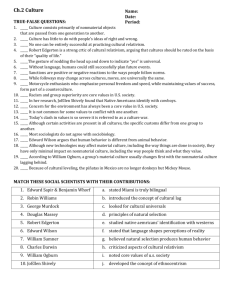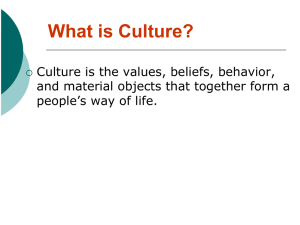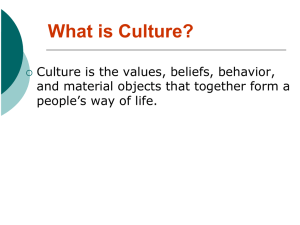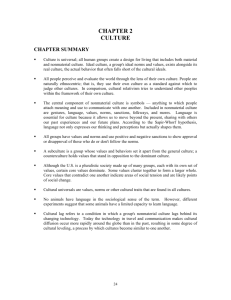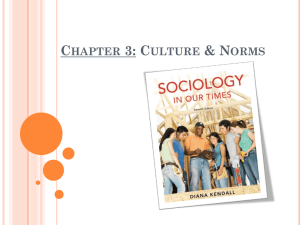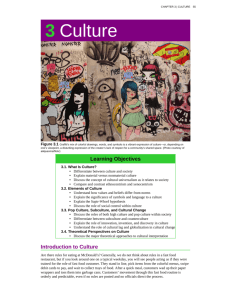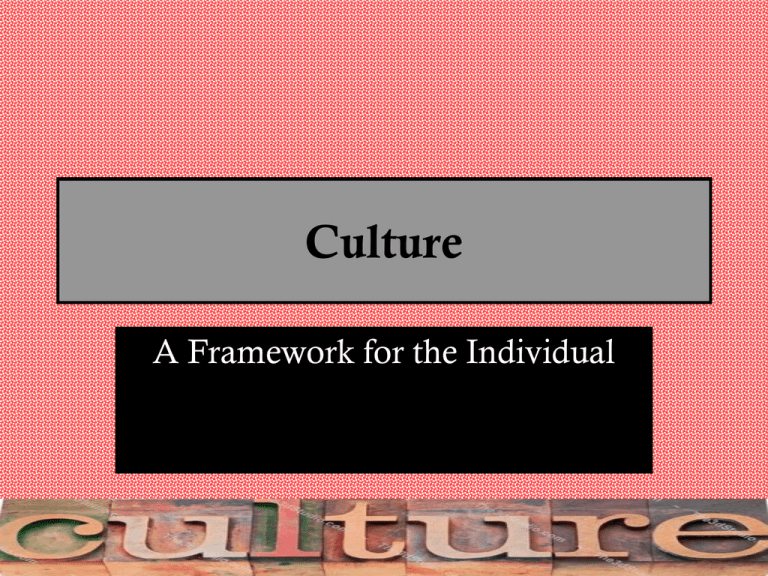
Culture
A Framework for the Individual
What is Culture?
• Culture consists of
– Material Culture items within a society that
you can taste, touch or feel
• Which includes concepts such as
– Symbols
– Language Universal Grammar, Cultural Transmission
…and
– Nonmaterial Culture nonphysical products
of society
– Gestures
– Values
– Norms Mores, Folkways, Taboos
The Study of Culture
• Is influenced by
–
–
–
–
Ethnocentrism
Xenophobia
Xenocentrism
Cultural Relativism
And should focus on
Various Types of Cultures
• Ideal Culture the values to which a culture
aspires
• Real Culture the way people actually behave
• Subcultures subsets of the dominant culture that
have distinct values, beliefs, and norms
• Counterculture subcultures whose values
and/or beliefs are in opposition to the dominant
group
And might discuss
• Multiculturalism concept that supports
the inherent value of different cultures in a
society
• Assimilation process by which minority
groups adapt to the dominant culture
Closer look at Material Culture
• One category of culture is material culture:
items within a society that you can taste,
touch, and feel.
– The jewelry, art, music, clothing, architecture,
and crafts a society creates are all examples of
material culture.
Example of Material Culture
• While seven countries (US, Japan, Russia,
Canada, Germany, France & UK) use more
than 46% of the world’s electricity and oil,
these countries combined hold only about
12% of the world’s population.
– What do these statistics tell you about their
material culture?
• You would likely stumble across many cars, air
conditioners, heaters, blow dryers and modern
convienences.
Closer look at Nonmaterial Culture
• Nonmaterial culture consists of the
nonphysical products of society, including
our symbols, values, rules and sanctions.
Nonmaterial Culture: Symbols
• Symbols represent, suggest, or stand for
something else.
• They can be words, gestures, or even
objects, and they often represent abstract or
complex concepts.
Examples of common symbols
Nonmaterial Culture: Language
• Language is a system of speech and/or
written symbols used to convey meaning
and communicate.
• Some languages exist only in the oral
tradition, while other languages are
expressed through both speech and writing
systems.
All cultures use some form of language.
Languages
• There are more than 6,000 different
languages on the planet.
• Due to conquest, commerce, and failure to
write down some languages, about half of
these are in danger of extinction.
• Two main factors determine the number of
speakers of a language: population size and
colonial history
Nonmaterial Culture: Universal
Grammar
• Noam Chomsky suggests that human
beings’ ability to use language comes from
common roots.
• All language contain what Chomsky calls a
“universal grammar”
– This term refers not to particular language rules
but the way in which language is constructed.
• The subject of a sentence generally is found at the
beginning of the sentence.
Nonmaterial Culture: Cultural
Transmission
• Culture often passes from one generation to
the next through language cultural
transmission
• Thanks to cultural transmission, you can use
the information others have learned to
improve your own life.
• Cultural transmission also helps spread
technology.
• Language not only advances our knowledge;
it also brings us together by helping us create
social consensus, or agreement.
• Language is inherently social: it serves as a
tool for sharing memories, making plans,
and building relationships.
The Sapir-Whorf Hypothesis
• Whorf & Sapir suggested that language and
thinking patterns are directly connected.
• Sapir & Whorf reached the conclusion,
known as the Sapir-Whorf hypothesis, after
studying many different languages and the
people who spoke them
Sapir-Whorf Hypothesis Proposes:
1. The difference in the structure of language
parallel differences in the thinking of the
people who speak the languages.
2. The structure of a language strongly
influences the speaker’s worldview.
Sapir-Whorf Hypothesis in Real
Terms
Imagine the English language did not have words for
left, right, backward, forward. Would you still be
able to understand these concepts? Probably not.
• Ongoing research into the Sapir-Whorf
Hypothesis suggests that because language
influences thinking, it also influences culture.
Nonmaterial Culture: Gesture
• Another symbol system that differs by
culture is gesture.
• Gestures are symbols we make using our
bodies, such as facial expressions, hand
movements, eye contact, and other types of
body language.
• A gesture’s symbolic meaning can vary
widely between cultures.
Texting Gestures
Nonmaterial Culture: Values
• Values, part of a society’s nonmaterial
culture, represent cultural standards by
which we determine what is good, bad,
right, or wrong.
• Sometimes, these values are expressed as
proverbs or sayings that teach us how to
live.
English Proverbs
• A bird in the hand is worth two in the bush
– It's better to have a lesser but certain advantage than the possibility of a
greater one that may come to nothing
• A chain is only as strong as its weakest link
– The proverb has a literal meaning, although the 'weakest link' referred to is
figurative and usually applies to a person or technical feature rather than the
link of an actual chain.
• A friend in need is a friend indeed
– A friend, (when you are) in need, is indeed a true friend. ('indeed')
• A leopard cannot change its spots
– The notion that things cannot change their innate nature
• A man who is his own lawyer has a fool for his client
– Literal meaning
• A picture paints a thousand words
– A picture tells a story just as well as a large amount of descriptive text.
• Cultures are capable of growth and change,
so it is possible for a culture’s values to
change over time.
Value Pairs, Clusters & Conflict
• Value pairs help us define values, usually in
terms of opposites.
– For every positive value, we have a negative one.
– We may also hold values that support or
contradict our other values
• Value clusters are two or more values that
support each other.
– Let’s say you value both equality and tolerance;
these values form a value cluster because they
are similar concepts that strengthen each other.
• When two or more values are at odds,
however, a value conflict occurs.
– For example, equality and racism are conflicting
values.
International Gestures Quiz
1. How would you let a
French person know
he’s boring you to
tears?
A. Pat your mouth and
let out a giant yawn
B. Mime playing an
imaginary flute
C. Push your nose with
your middle and index
fingers
2. Your Puerto Rican
friend wiggles her
nose at you. What’s
she saying?
A. “What’s going on?”
B. “I smell a rat—
literally”
C. “My nose itches”
International Gestures Quiz
3. Which gesture is
considered offensive
in Egypt?
A. Using the right hand
for eating
B. Showing someone the
sole of your shoe
C. Walking hand in hand
with someone
Answers:
1. B- mime playing an
imaginary flute
2. A- “What’s going on”
3. B- Showing someone
the sole of your shoe
Cultural Etiquette
Country
Custom
England/Scotland &
Wales
Appointments are essential. You may be ten minutes late but not
ten minutes early!
Greece
Be careful not to praise a specific object too enthusiastically or the
host may insist on giving it to you.
Libya
If you are invited to a Libyan home for dinner, only men will be
present. Take a gift for the host but not for his wife.
Senegal
Never eat food with the left hand, as this is considered offensive
Zambia
Avoid direct eye contact with members of the opposite sex—it may
suggest romantic overtures
Saudi Arabia
It is an insult to sit in such as way as to face your host with the
soles of your shoes showing.
China
A visit to a Chinese home is rare—unless the government has given
prior approval
Cultural Etiquette Continued
• Visit http://www.culturecrossing.net/ on your
phones.
• Select 6 countries not already mentioned so far
and find two examples of cultural etiquette that
you find the most strange or interesting.
• Write your findings on a piece of paper with your
name on it!
Culture: Norms
How can people uphold and enforce values in
everyday life?
• They might develop rules for appropriate
behavior based on those values, called
norms.
– Norms are conditional, can vary from place to
place.
Example of a Norm
The way you behave at a football game is
certainly different then how you behave at a
funeral.
– Our behaviors are linked to the situation.
It is normal to cry at a funeral, and not so acceptable
to cry at a football game unless your team got
spanked!
Culture: Sanctions
• Norms provide the justification for
sanctions.
• A sanction is a prize or punishment you
receive when you either abide by a norm or
violate it.
– If you do as you are supposed to, you get a
positive sanction; if you break the rules you get
a negative sanction.
Sanctions: Formal vs. Informal
• Most sanctions are informal, like when your
friend rolls her eyes at your terrible joke.
• However, if we violate a law or some formal
written rule, we receive a formal negative
sanction.
• Sanctions are both positive and negative, can
reinforce values by rewarding people who hold
those values and punishing those who have
opposing values.
Examples of Positive Sanctions
A person who performs well at his or her job and is
given a salary raise or a promotion is receiving a
positive sanction. When parents reward a child
with money for earning good grades, they are
positively sanctioning that child’s behavior.
Examples of Negative Sanctions
Imprisoning a criminal for breaking the law,
cutting off a thief’s hands for stealing, and
taking away a teenager’s television privileges
for breaking curfew are all negative sanctions.
Folkways, Mores, Taboos, OH MY!
• Folkways are informal types of norms.
– They provide a framework for our behavior and are
based on social expectations.
– Because they are a less serious type of norms, the
sanctions applied are less severe
For example, if you see a person struggling with packages,
you will hold the door for him or her. If you let the door
slam on the person, you might be considered rude, but
won’t go to jail.
• Folkways are often social customs that,
when violated, call for minor informal
negative sanctions if any at all.
Mores (pronounced MORE-ayes)
• Although folkways are informal norms,
mores are more serious.
• Mores are norms that represent a
community’s most important values.
• Taboo is an act that is socially
unacceptable.
Examples of Mores & Taboos
If you murder a person, you’ve violated one of
society’s mores. People who violate mores are given
a particularly serious type of formal negative
sanction.
• In this way, mores can be considered the basis
of laws in a society.
Acts that lead us to feel revulsion, such as murder
itself are taboo.
Silly Laws Still on the Books
State
Law
Alabama
It is illegal for a driver to be blindfolded while driving.
Arizona
Hunting camels is prohibited
Florida
If an elephant is left tied to a parking meter, it still has to pay the meter
fee
Illinois
Cannot contact the police before entering the city in a car
Iowa
Kisses can last for up to but not longer than 5 minutes
Maine
You must not step out of a plane in flight
Massachusetts
No gorilla is allowed in the back seat of a car
Minnesota
You may not cross state lines with a duck on your head
Vermont
Whistling underwater is illegal
Washington
It is illegal to pretend your parents are rich
The Study of Culture
• When you study culture it’s a good idea to
consider whether a particular behavior or
event is a cultural universal, or common to
all cultures.
For example, funeral rites are a cultural universal
because all cultures have methods of disposing
of the dead.
Micronesia Case Study
Bronislaw Malinowski witnessed a funeral ritual
in which native islanders ate part of the dead
person to maintain a connection. After eating,
they would vomit in an attempts to create
distance from the deceased.
Ethnocentrism & Cultural
Relativism
When studying culture from a sociological
perspective, you must not allow your personal
biases to complicate your understanding
(Weber).
Ethnocentrism
• Ethnocentrism occurs when a person uses
his or her own culture to judge another
culture.
Nearly all people in the world are ethnocentric, but
ethnocentrism is potentially dangerous to
sociologists because it can lead to incorrect
assumptions about different cultures.
Xenophobia
• Xenophobia refers to fear and hostility
toward people who are from other countries
or cultures.
When the United States entered World War II after
Japan bombed Pearl Harbor in 1941, people in the
US began to fear Japanese Americans and locked
many in internment camps.
Xenocentrism
Not all personal biases result in a negative view
of foreign cultures.
• Sometimes, we engage in xenocentrism
when we perceive other groups or societies
as superior to our own.
Cultural Relativism
Thinking like a sociologist means striving to
practice cultural relativism when studying other
cultures.
• Cultural relativism consists of a deliberate
effort to appreciate a group’s ways of life in
it’s own context, without prejudice.
• Philosophers sometimes refer to this effort as
normative relativism because it bases the
evaluation of a society on that society’s own
norms.
Examples of Normative Relativism
In some Islamic countries, women are not encouraged
to seek education. Within the context of these
countries, this practice could be interpreted as a
normal function of that culture.
However, if women in the US were not granted an
education, the practice would seem unfair because
it would violate US cultural norms.
Criticisms
• Some people, however, argue that there are
universal human values that are standards by
which we should evaluate cultures.
• According to this argument, women in every
culture should be educated, and any culture
that does not allow this is inferior and
exploitive of women.
Culture Lag
• Culture Lag happens when social and
cultural changes occur at a slower pace than
technological changes.
• This is often the case when new technology
enters and changes a culture.
Culture Shock
Have you ever traveled to a foreign country and
been stunned by how the culture differed from
your own? If so, you were probably
experiencing culture shock.
• Culture shock occurs when a person
encounters a culture foreign to his or her
own and has an emotional response to the
differences between the cultures.
Ideal versus Real Culture
Is there a difference between culture as we’d like
it to be and culture as it really is?
Often the answer is, YES.
• Ideal culture represents the values to which
a culture aspires, and real culture represents
a culture’s actual behaviors.
Examples of Ideal & Real Culture
Our society aspires to equality, and yet a brief
look at the data shows that minorities still
suffer from inequality in the United States.
They experience more poverty, lower incomes,
and less access to health insurance.
Subcultures
• Groups with a common interest may form a
subculture.
• A subculture is a subset of the dominant
culture that has distinct values, beliefs, and
norms.
• In complex societies, subcultures allow
people to connect with other people who
have similar interests.
Churches, civic organizations, clubs and even
online communities can become subcultures.
Facebook Activity
• Log on to your Facebook (if you have one,
or look on with a friend)
– Identify a group you belong to on Facebook.
• Make a list of the values of that culture.
• What do those values tell you about that group?
Global Village?
• In the 1960s, Marshall McLuhan popularized
the term “global village,” which refers to the
“shrinking” of the world through immediate
electronic communications.
• McLuhan’s work suggests that time and space
differences are rapidly becoming irrelevant as a
result of technology.
Virtual “Global Village”
Is technology really bringing people closer together?

